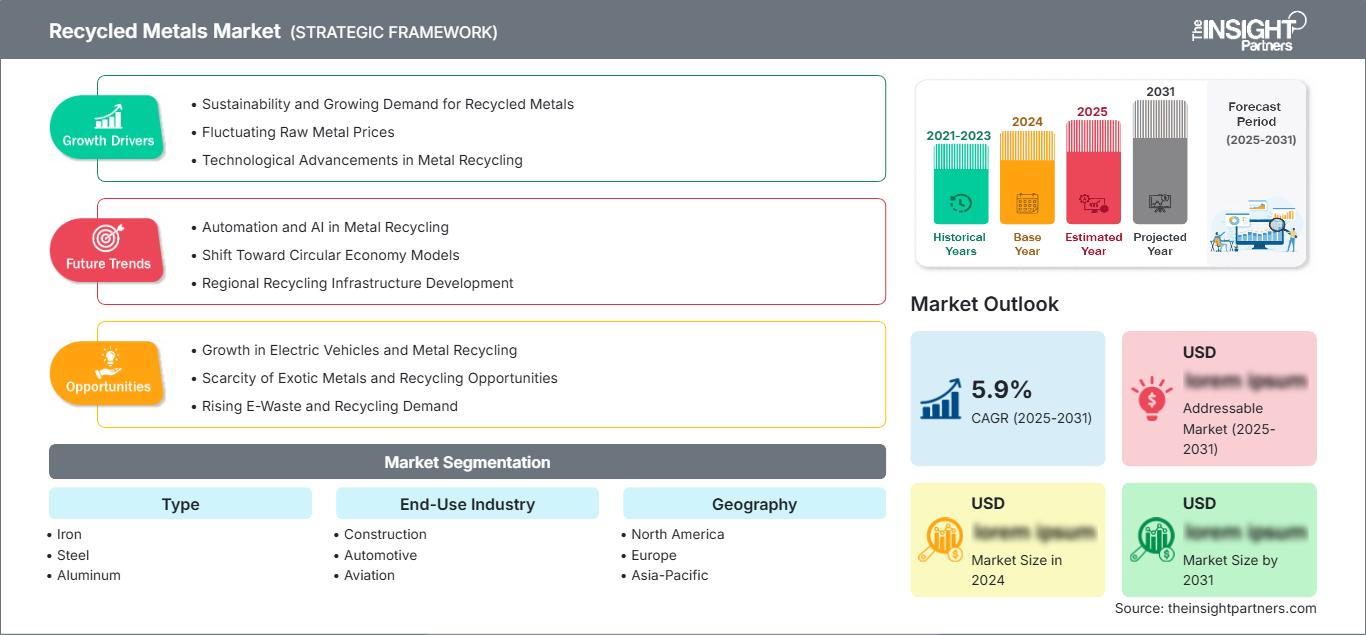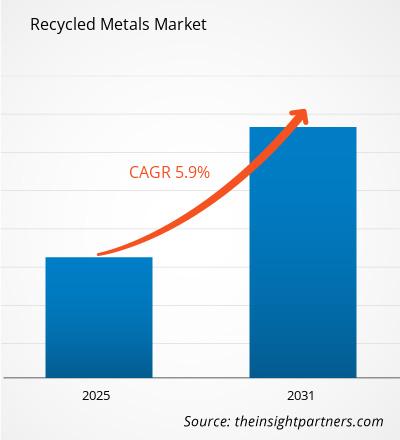Der Markt für recycelte Metalle wird bis 2031 voraussichtlich ein Volumen von 502,31 Milliarden US-Dollar erreichen. Für den Zeitraum 2025–2031 wird ein jährliches Wachstum von 3,6 % erwartet.
Der Bericht ist nach Metallart (Eisen, Stahl, Aluminium, Kupfer, Nickel, Platin, Blei, Zinn und Sonstige) und nach Endverbrauchsbranche (Bauwesen, Automobilindustrie, Luftfahrt, Konsumgüter, Industriemaschinen, Verpackung und Sonstige) segmentiert. Der Bericht umfasst fünf Regionen: Nordamerika, Europa, Asien-Pazifik, Naher Osten und Afrika sowie Süd- und Mittelamerika und die wichtigsten Länder jeder Region. Die globale Analyse wird weiter auf regionaler Ebene und für die wichtigsten Länder aufgeschlüsselt. Der Bericht gibt die Werte für die oben genannten Analysen und Segmente in US-Dollar an.
Zweck des Berichts
Der Bericht „Markt für recycelte Metalle“ von The Insight Partners beschreibt die aktuelle Marktlage und das zukünftige Wachstum sowie die wichtigsten Triebkräfte, Herausforderungen und Chancen. Dies wird verschiedenen Akteuren im Geschäftsbereich Einblicke ermöglichen, wie beispielsweise:
- Technologieanbieter/Hersteller: Um die sich entwickelnde Marktdynamik zu verstehen und potenzielle Wachstumschancen zu erkennen, können sie fundierte strategische Entscheidungen treffen.
- Investoren: Um eine umfassende Trendanalyse hinsichtlich Marktwachstumsrate, Finanzprognosen und Chancen entlang der Wertschöpfungskette durchzuführen.
- Regulierungsbehörden: Um Richtlinien zu regulieren und Aktivitäten auf dem Markt zu überwachen, mit dem Ziel, Missbrauch zu minimieren, das Vertrauen der Anleger zu wahren und die Integrität und Stabilität des Marktes zu gewährleisten.
Marktsegmentierung für recycelte Metalle Typ
- Eisen
- Stahl
- Aluminium
- Kupfer
- Nickel
- Platin
- Blei
- Zinn
Endverbrauchsbranche
- Bauwesen
- Automobilindustrie
- Luftfahrtindustrie
- Gebrauchsgüter
- Industriemaschinen
- Verpackungsindustrie
Sie erhalten kostenlos Anpassungen an jedem Bericht, einschließlich Teilen dieses Berichts oder einer Analyse auf Länderebene, eines Excel-Datenpakets sowie tolle Angebote und Rabatte für Start-ups und Universitäten.
Markt für recycelte Metalle: Strategische Einblicke

-
Holen Sie sich die wichtigsten Markttrends aus diesem Bericht.Dieses KOSTENLOSE Beispiel umfasst Datenanalysen, die von Markttrends bis hin zu Schätzungen und Prognosen reichen.
Wachstumstreiber des Marktes für recycelte Metalle
- Nachhaltigkeit und steigende Nachfrage nach recycelten Metallen: Mit zunehmendem Umweltbewusstsein ist Nachhaltigkeit heute in allen Branchen ein wichtiges Thema. Regierungen, Unternehmen und Verbraucher werden immer umweltbewusster, was die Nachfrage nach recycelten Metallen ankurbelt. Metallurgisches Recycling schont natürliche Ressourcen, spart Energie und reduziert die Auswirkungen der Umweltzerstörung. Vorschriften wie CO₂-Steuern und Abfallmanagementstandards ermutigen Unternehmen zur Einführung von Kreislaufwirtschaftsmodellen und fördern so die Nachfrage nach recycelten Metallen als umweltfreundliche Alternative zu Primärmetallen.
- Schwankende Rohmetallpreise: Globale Preisschwankungen bei Primärmetallen (Aluminium, Kupfer und Stahl) beeinflussen häufig die Nachfrage nach recycelten Metallen. Wenn der Abbau von Rohmetallen zu teuer wird, werden diese recycelt. Der jüngste Trend in diesem Bereich ist die Automobil- und Bauindustrie, wo die Nachfrage nach Metallen weiterhin hoch ist und Metallrecycling neben Nachhaltigkeit auch einen Preisvorteil bietet. Recycling bietet Unternehmen mit schwankenden Metallpreisen Stabilität, da es eine kostengünstigere Lieferkette ermöglicht.
- Technologische Fortschritte im Metallrecycling: Die technologischen Fortschritte im Metallrecycling führen zu effizienteren Prozessen und qualitativ hochwertigeren Endprodukten. Verbesserte Sortierverfahren ermöglichen eine bessere Nutzung der automatisierten Trennung und ein effektiveres Schmelzen, was eine höhere Reinheit und Ausbeute der zu recycelnden Metalle gewährleistet. Innovationen in dieser Technologie haben das Recycling kostengünstiger gemacht und ermöglichen es mehr Branchen, die verfügbaren recycelten Metalle in anspruchsvolleren Anwendungen zu nutzen, darunter die Elektronik- und Automobilindustrie, die besonders materialintegritätsintensiv sind. Die neueren Recyclingtechnologien machen die Gewinnung von Edelmetallen wirtschaftlicher und verbessern so den Gesamtmarkt.
Zukünftige Trends im Markt für recycelte Metalle
- Automatisierung und KI im Metallrecycling: Automatisierungs- und KI-Technologien werden in der Metallrecyclingindustrie eingesetzt, um die Sortierung, Verarbeitung und den Transport von Altmetallen zu optimieren. Automatisierte Sortiersysteme auf Basis von KI und maschinellem Lernen verbessern die Metallidentifizierung mit höherer Genauigkeit, steigern die Qualität der recycelten Materialien und senken die Betriebskosten. Innovationen, die durch diese Fortschritte ermöglicht werden, beschleunigen und sichern den Recyclingprozess – ein Vorteil, den sowohl große Recyclingunternehmen als auch kleine Betriebe schätzen.
- Wechsel hin zu Kreislaufwirtschaftsmodellen: Immer mehr Branchen setzen auf Kreislaufwirtschaftsmodelle. Dabei werden nicht nur Altmetalle recycelt, sondern auch Produkte entwickelt, die leichter zu recyceln sind. Dies ist in vielen Sektoren wie der Elektronik-, Automobil- und Verpackungsindustrie der Fall, wo Hersteller recycelbare Metalle in ihre Designs integrieren. Unternehmen nutzen Rücknahmeprogramme, um gebrauchte Produkte zum Recycling zu sammeln. Dieser Wandel hin zu einer Kreislaufwirtschaft hat dem Recyclingmetallmarkt durch ein erhöhtes Angebot an Altmetallen zugutekommen.
- Entwicklung regionaler Recyclinginfrastrukturen: Regionale Recyclinginfrastrukturen gewinnen im Recyclingmetallmarkt zunehmend an Bedeutung. Insbesondere Länder der Europäischen Union und Nordamerikas arbeiten daran, ihre inländischen Recyclingkapazitäten auszubauen, um ihre Abhängigkeit von importierten Altmetallen zu verringern. Der regionale Trend geht einher mit der zunehmenden Bedeutung, die der Senkung der Transportkosten und der Reduzierung des CO₂-Fußabdrucks beim grenzüberschreitenden Transport von Altmetall beigemessen wird.
Marktchancen für recycelte Metalle
- Wachstum bei Elektrofahrzeugen und Metallrecycling: Weltweit ist ein Wachstum bei Elektrofahrzeugen zu verzeichnen, wodurch die Nachfrage nach Aluminium, Kupfer und Lithium steigt. Diese Metalle werden in Elektrofahrzeugen, insbesondere in Batterien und Motoren, sowie in vielen Karosserieteilen zur Gewichtsreduzierung verwendet. Ihr Recycling bietet die Möglichkeit, die steigende Nachfrage umweltfreundlich zu decken. Es besteht Bedarf an mehr recycelten Metallen, um die geförderten Mengen zu ergänzen und somit die Auswirkungen des Abbaus dieser Metalle zu verringern.
- Knappheit seltener Metalle und Recyclingmöglichkeiten: Der steigende Verbrauch seltener und exotischer Metalle wie Lithium, Kobalt und Seltenerdmetalle in Elektronikprodukten und Anlagen zur Erzeugung erneuerbarer Energien eröffnet der Recyclingbranche einen neuen Markt. Für diese Metalle gibt es derzeit keine verfügbaren Recyclingverfahren. Mit fortschreitender Technologie könnten jedoch neue Verfahren entwickelt werden, um diese Materialien aus ausgedienten Elektronikgeräten, verbrauchten Batterien und Infrastrukturen für erneuerbare Energien wirtschaftlich zu recyceln. Dies würde eine neue Einnahmequelle für den Recyclingmetallmarkt schaffen und zum weltweiten Wandel hin zu saubererer Energie beitragen.
- Steigende Nachfrage nach Elektroschrott und Recycling: Da das Volumen an Elektroschrott weltweit zunimmt, bietet ausrangierte Unterhaltungselektronik ein erhebliches Potenzial für das Recycling von Metallen. Zu den im Elektroschrott enthaltenen Metallen gehören Gold, Silber, Kupfer und Palladium. Die gesetzlichen Regelungen und ein gesteigertes Bewusstsein der Verbraucher würden die Verbesserung der Recyclingmethoden für Elektroschrott vorantreiben. Dies würde der Welt dringend benötigte Metalle liefern und gleichzeitig die Umweltprobleme, die durch die Entstehung von Elektroschrott entstehen, lösen. Mit der Verschärfung der Elektroschrott-Recyclinggesetze durch die Länder können sich spezialisierte Unternehmen in diesem Bereich größere Marktanteile sichern.
Markt für recycelte Metalle
Die regionalen Trends und Einflussfaktoren auf den Markt für recycelte Metalle im gesamten Prognosezeitraum wurden von den Analysten von The Insight Partners ausführlich erläutert. Dieser Abschnitt behandelt außerdem die Marktsegmente und die geografische Verteilung des Marktes für das Management von Herzrhythmusstörungen in Nordamerika, Europa, Asien-Pazifik, dem Nahen Osten und Afrika sowie Süd- und Mittelamerika.
Umfang des Marktberichts zu recycelten Metallen
| Berichtsattribut | Einzelheiten |
|---|---|
| Marktgröße in 2024 | US$ XX Billion |
| Marktgröße nach 2031 | US$ 502.31 Billion |
| Globale CAGR (2025 - 2031) | 3.6% |
| Historische Daten | 2021-2023 |
| Prognosezeitraum | 2025-2031 |
| Abgedeckte Segmente |
By Typ
|
| Abgedeckte Regionen und Länder |
Nordamerika
|
| Marktführer und wichtige Unternehmensprofile |
|
Dichte der Akteure im Markt für recycelte Metalle: Auswirkungen auf die Geschäftsdynamik
Der Markt für recycelte Metalle wächst rasant, angetrieben durch die steigende Nachfrage der Endverbraucher. Gründe hierfür sind unter anderem sich wandelnde Verbraucherpräferenzen, technologische Fortschritte und ein wachsendes Bewusstsein für die Vorteile des Produkts. Mit steigender Nachfrage erweitern Unternehmen ihr Angebot, entwickeln innovative Lösungen, um den Verbraucherbedürfnissen gerecht zu werden, und nutzen neue Trends, was das Marktwachstum weiter ankurbelt.

- Holen Sie sich die Markt für recycelte Metalle Übersicht der wichtigsten Akteure
Wichtigste Verkaufsargumente
- Umfassende Abdeckung: Der Bericht bietet eine umfassende Analyse der Produkte, Dienstleistungen, Typen und Endnutzer des Marktes für recycelte Metalle und vermittelt so ein ganzheitliches Bild.
- Expertenanalyse: Der Bericht basiert auf dem fundierten Wissen von Branchenexperten und Analysten.
- Aktuelle Informationen: Der Bericht gewährleistet Geschäftsrelevanz durch die Berücksichtigung aktueller Informationen und Datentrends.
- Anpassungsmöglichkeiten: Dieser Bericht kann an spezifische Kundenanforderungen angepasst werden und sich optimal in die Geschäftsstrategien integrieren.
Der Forschungsbericht zum Markt für recycelte Metalle kann somit maßgeblich dazu beitragen, das Branchenszenario und die Wachstumsaussichten zu entschlüsseln und zu verstehen. Auch wenn einige berechtigte Bedenken bestehen, überwiegen die Vorteile dieses Berichts insgesamt die Nachteile.
- Historische Analyse (2 Jahre), Basisjahr, Prognose (7 Jahre) mit CAGR
- PEST- und SWOT-Analyse
- Marktgröße Wert/Volumen – Global, Regional, Land
- Branchen- und Wettbewerbslandschaft
- Excel-Datensatz
Aktuelle Berichte
Erfahrungsberichte
Grund zum Kauf
- Fundierte Entscheidungsfindung
- Marktdynamik verstehen
- Wettbewerbsanalyse
- Kundeneinblicke
- Marktprognosen
- Risikominimierung
- Strategische Planung
- Investitionsbegründung
- Identifizierung neuer Märkte
- Verbesserung von Marketingstrategien
- Steigerung der Betriebseffizienz
- Anpassung an regulatorische Trends






















 Kostenlose Probe anfordern für - Markt für recycelte Metalle
Kostenlose Probe anfordern für - Markt für recycelte Metalle